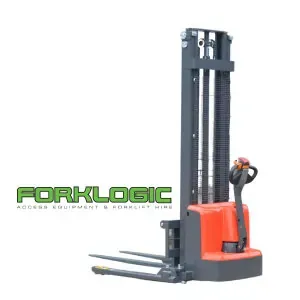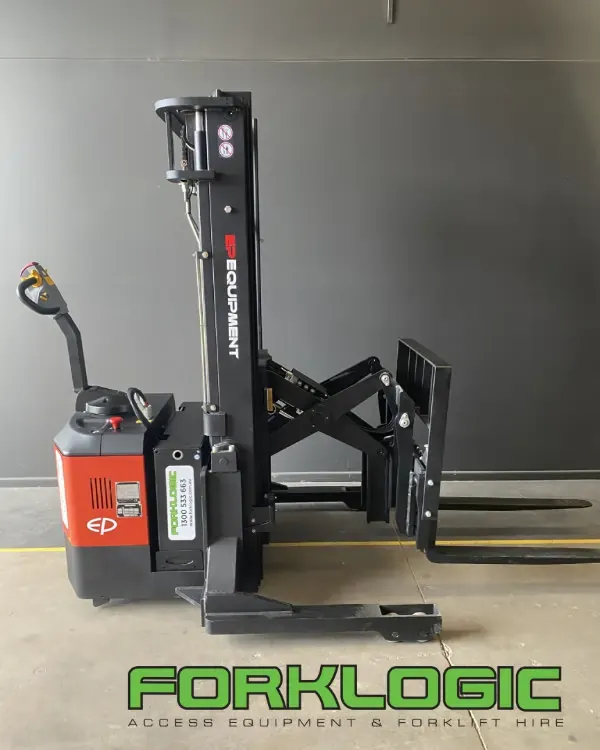Pros & features of different styles of forklifts
PALLET TRUCKS
Although these units are not considered forklifts as such, pallet trucks (often referred to as pallet jacks) are a great value-for-money solution for moving pallets on the shop floor. Pallet trucks are designed to lift pallets around 150mm from the ground so they can be shifted to a storage position. No license is required to operate a pallet truck and they are very simple to use.
There are two main configurations, hand pallet trucks (manual) and electric pallet trucks.
Hand Pallet Trucks
- Manual travel by “pushing” the unit to the desired location
- Manual lift by way of using the handle to “pump” and lift the pallet of the ground
- Great for hard-level surfaces and relatively light loads (up to 2T)
- No forklift license is required to operate

Electric Pallet Trucks
- Electric-powered travel and lift, eliminate any physical exertion
- A smart, safe way to move heavy products from A to B (up to 2T)
- Simple to operate
- No license required

WALK BEHIND STACKER FORKLIFTS
These units are great entry-level forklifts and will suit 90% of light to medium-duty applications.
Walk-behind stackers forklifts can be used to move, stack, store load/unload pallets in small or tight warehouses. The units are battery electric with either internally or externally mounted battery chargers. The battery chargers are generally 240 v 10amp e.g. standard household power point.
Operator controls are on the handle/tiller and this type of forklift is very simple to drive. The units have straddle legs protruding from the body of the unit to help balance the load. The reason to incorporate straddle legs into the design is so the units can be used in the tightest warehouse spaces. The pallet sits between the straddle legs, close to the body of the unit, creating a short overall length that aids in maneuvering in tight spaces. These legs are normally wider than a pallet so you can drive or straddle the legs around a pallet, which in turn allows the forks to completely enter the pallet. The straddle legs are always the furthest point forward, ground level pallets must be positioned so that there is always enough room beside the pallet for the straddle legs to straddle the pallet e.g. you can not place pallets hard up against each other.
- No forklift license is required to operate
- Small/compact so are ideal for working in tight spaces (1900-2100mm aisles)
- 3000-4500mm are the most common lift heights
- High lift heights and up to 1500kg capacity are possible
- Will unload most trucks without double-handling

WALK BEHIND REACH FORKLIFTS
Walk-behind reach forklifts are a brilliant design in that they allow full functionality just like a conventional forklift and still can be used in tight spaces without the need for a forklift license.
The units are battery electric and will normally use an externally mounted battery charger. The battery charger in most cases will only require a standard power point (240v 10amp) unless larger battery configurations are needed.
Operator controls are on the handle/tiller and this type of forklift is very simple to drive. The units have straddle legs protruding from the body of the unit. The reason to incorporate straddle legs into the design is so that the units can be used in the tightest warehouse spaces. The pallet sits between the straddle legs, close to the body of the unit, creating a short overall length that aids maneuvering in tight spaces.
This type of unit uses a Pantograph (Scissor) Reach system which extends the entire fork carriage along with the forks forward. This is to allow the forks (tynes) to move out past the straddle legs, allowing the operator to pick up pallets without needing to drive the forklift’s straddle legs around or straddle the pallet. The real benefit of this type of unit is that by incorporating the Pantograph (Scissor) Reach Mechanism, there are no restrictions with how pallets are placed or stacked on the ground, unloading both sides of a truck from the one side is often possible and has the capability to load/unload dual rear axle trucks (Walk Behind Stackers may have difficulty due to the straddle legs interfering with the truck wheels, stopping the forks fully engaging into the load).
- No forklift license is required to operate
- Ideal to work in tight spaces (2600mm Aisles)
- 3000-4500mm are the most common lift heights
- Options include high lift heights and up to 1500kg capacity
- Offers all the functionality of a conventional forklift in less space.

INTERNAL COMBUSTION (CONVENTIONAL) FORKLIFTS
Internal Combustion Forklifts are what most people recognise when they think about forklifts, and are considered conventional forklifts. These types of forklifts are either diesel or LPG/petrol fueled units and are a great workhorse. A forklift license is required to operate these units.
There are many and varied configurations with capacities from 1.5T up to 12 000kg and beyond! The most common range is from 1500kg up to 3000kg with lift heights from 3000 mm - 5000 mm, amongst these ranges are two basic configurations.
Tyre options include cushion tyres (solid) or pneumatic tyres.
Cushion tyre
- Great for Indoor/Outdoor use
- Cushion tyres are small and solid, eliminating punctures but may ride a little harder
- Very maneuverable due to the compact size
Pneumatic tyre
- Excellent versatile outdoor forklift, that can be used indoors
- Pneumatic tyres provide a more comfortable ride and minimise shaking or bouncing of the load
- Pneumatic tyres can be foam-filled or swapped with optional solid (cushion) tyres eliminating punctures
- Much like a car to drive, which is easier for operators

BATTERY ELECTRIC COUNTERBALANCE FORKLIFTS
Battery Electric Counterbalance Forklifts are a great warehouse unit, and durable enough to be used in most outdoor yards. These units are battery-powered and generally will need a 3-phase power outlet for the externally mounted battery charger. Being battery powered they are ideal for mainly indoor operations as there are no health risks due to emissions or exhaust soot that can damage/soil your products. Best of all with no CO2 emissions, they are good for the environment.
Battery electric forklifts are much like conventional IG forklifts, only battery-powered. This means that you will need a forklift license to operate this type of equipment.
The most popular configurations are 3-wheel or 4-wheel electric forklifts.
3 Wheel Battery Electric Counterbalance
- This configuration allows to unit to be much shorter which aids in turning in tight spaces
- Ideal for work in 3300-3500mm aisles
- 4000-5500mm are the most common lift heights
- Great for unloading/loading in tight yards
- Units can be configured to enter shipping containers for unloading/loading
- Options include high lift heights and lift capacities of up to 1800kgs
4 Wheel Battery Electric Counterbalance
- Ideal yard truck
- Can work in 3600-3800mm aisles
- 4000-5500mm are the most common lift heights
- Great for unloading/loading in tight/medium size yards
- Units can be configured to enter shipping containers for unloading/loading
- Options include high lift heights and lift capacities of up to 2500kgs

RIDE ON REACH FORKLIFTS
Ride On Reach forklifts are designed to get the most out of your warehouse space, use all of your available ceiling height, and make the most of your floor plan by setting up tight aisles. These units are true warehouse units and can also be used to unload/load trucks depending on the application.
Ride On Reach Forklifts are battery-powered and in most cases require a 3-phase power outlet for the externally mounted battery charger. These units require a forklift license to operate, much like a normal forklift.
There are a couple of very different configurations and each has its own merits, these are Moving Mast Reach and Pantograph (Scissor) Reach. As a rule, the operator is seated in the Moving Mast Reach Forklift whereas in the Pantograph Reach the operator usually stands.
- 2800-3100mm aisles
- 5000-8500mm are the most common lift heights
Moving Mast Reach
- Ideal if the operator spends a lot of time on the forklift, due to the seated position
- To get the most out of available storage space you should use a bottom pallet racking beam
- It can be used outside on flat surfaces due to centre mounted drive wheel
Pantograph (Scissor) Reach
- Easy for the operator to get on/off, due to the stand-up configuration
- Mast fixed which allows for product overhang in racking beam levels as the pallets/products are never exposed to the mast e.g. the mast is stationary
- Can get more out of storage space in low pallet racking levels
- Consideration needs to be given to outdoor surfaces due to the drive wheel configuration
Some points to consider when choosing a forklift
Forklift Masts
Generally, there are two common mast configurations, the Two-Stage Mast and the Three-Stage Mast. Two-Stage Masts are more common and are considered a basic configuration; Two-Stage Masts have a taller overall lowered height than a Three-Stage Mast e.g. when the fork tines are in the lowered position (ground level), the very top of the mast is quite high.
As an example only, a Two-Stage Mast may lift to say 4300mm and have an overall lowered height of 3600mm. Where Three-Stage mast with an equivalent 4300mm lift height may have an overall lowered height of only 2100mm. In some applications the short overall lowered height of a Three-Stage Mast can be beneficial when going through low doorways, working under mezzanine floors, or entering shipping containers. A Three-Stage Mast also gives you greater flexibility if your business or application changes.
Forklift Options
Detailed below are some features & benefits available that may not be standard on some forklifts (depending on the configuration/manufacturer of the forklift, these features may not be available/suitable).
- Side shift: Allows the fork tines to shift sideways. This helps to line up the fork tines when unloading/loading from trucks or pallet racking.
- Fork positioner: Allows the fork tunes to move independently of each other. Useful when lifting loads of varying sizes.
- Weight scales: Display the weight of the pallet/load when placed on the fork tines, great if you need to verify your actual product weight for freight companies.
- Warning lights: These may include Brake Lights, Tail Lights, Reversing Lights, Blinkers, Head Lights, Flashing Amber Warning Lights, and Audible Travel Alarms. All these aid in increasing the visibility of the forklift to pedestrians and traffic. (Standard in forklifts in Australia)
- Puncture-proof tyres: Some forklift tyres can be upgraded to solid or puncture-proof proof eliminating punctures and in some cases providing more wear material, effectively increasing tyre life.
- Battery Watering Kits: Deep cell battery-powered forklifts require the battery water levels to be checked and adjusted routinely. There are battery watering systems that can assist in making this task much easier.
- Operator Log-On Systems: Some of these systems will lock out unauthorised personnel, log forklift impact, control forklift speed, provide detailed reports on forklift usage.
Forklift Licensing
Workcover NSW & Workcover QLD stipulates only a licensed operator can drive a ride-on style forklift.
Expert forklift information & advice
For more information and expert advice on choosing the right forklift for your workplace requirement contact the team at